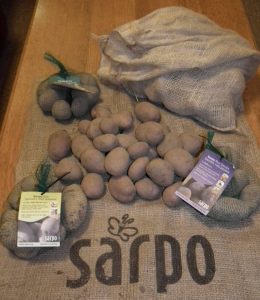Deciding how many seed potatoes to buy is not as simple as you might think at first. But a bit of thought and a little juggling will solve the problem. This article shows you a way to work out how many seed potatoes you need to produce the crop you want.
There are three main factors to take into account, which are covered below.
How many Potatoes do you Need to Grow?
Potatoes are one of our staple crops. There was a time when people ate potatoes at least once a day. Now we eat more varied staples like rice and pasta instead of potatoes. Because people did more manual work and walked a lot more, they also ate more at each meal than we do now.
Average general consumption statistics aren’t particularly useful. We’re all different and so the best way to estimate how many potatoes to grow to be self sufficient, estimate what your family eats. As a rule, 2 people will eat around 400 to 500 grams of potatoes per meal.
Eating potatoes three to four times per week would, therefore, give an annual consumption for two people between 60kg and 100kg That’s quite a wide spread, but it does give a ‘ball park’ estimate to work with.
Available Space for Potatoes
If you’ve got a full 10 rod allotment, 300 square yards or 250 square metres, then with a traditional three course rotation you would have a third of that space available for potatoes and other root crops. Many plots now are half size or something in between. There’s no point in buying seed potatoes you haven’t the room to plant.
Standard spacing for potatoes is to plant early varieties 30 cm apart in rows 60 cm apart. Maincrop varieties need more space and should go 45 cm apart in rows 75 cm apart. Keep those figures in mind, you’ll need them later to check you have enough room.
You can work out how many rows you can fit in and how many seed tubers you can fit in each row. This enables you to estimate the weight of seed potatoes to get.
The Dig for Victory plan allowed for 3 rows of earlies and 6 rows of maincrop, each row being 30 feet (9.14 metres) long. This plan allocated about 60 square metres to potatoes and would have produced around 45 kg of early varieties and 160 kg of maincrop potatoes.
Type / Variety of Potatoes Grown
Some potato varieties produce a usable crop in as little as 12 weeks and are known as early varieties. That includes second earlies which take a little longer but all earlies are treated the same for spacing. Others are called maincrop varieties and usually take 20 to 26 weeks to produce their crop.
Early varieties produce less crop per plant than maincrop varieties more which also generally store better. Earlies will keep for a while but are best used to bridge the gap between the stored crop being finished and the maincrop arriving.
Early varieties have an advantage of maincrops in that their crop is usually ready before blight becomes a problem. Having said that, with resistant varieties like the Sarpo family, blight is not as much of a concern as it used to be.
Some varieties are more more productive than others. Sarpo Mira are a blight-resistant, vigorous maincrop that give huge yields. Orla is unusual in that it can be harvested as an early or left to bulk up like a maincrop variety. Check individual descriptions when buying.
Seed to Crop Ratio
- Early varieties should give around 7 kg per kilogram of seed. 1:7
- Maincrop varieties should produce around 12 kg per kilogram of seed. 1:12
Seed Potatoes per Kilogram
The ideal seed potato tuber is about the size of a hen’s egg. The standard is that the tuber will fall through a 55 mm square, but not through a 35 mm square. This means that the number in a kilogram could be as low as 8 but equally could be as high as 16.
Generally expect 12 to 14 tubers per kilo. Don’t worry if the tubers are on the small size, once the plants get going it won’t make any real difference to the crop. Large tubers can be cut to provide more plants. See Largest Yield from One Seed Potato Competition
Method to decide how many seed potatoes to order.
To recap:
- Decide how many potatoes you want to grow for your needs
- Decide what varieties – earlies and maincrops – you want to grow
- Check you have enough space
- Divide required yield by 7 for early types and 12 for maincrop types.
 Potatoes – A Guide to Growing, Harvesting, and Storing Potatoes eBook
Potatoes – A Guide to Growing, Harvesting, and Storing Potatoes eBook
Because I get so many questions about potatoes, I’ve produced a 76 page e-book on them.
It covers different growing methods as well as coping with diseases and problems, harvesting, storing and some great recipes too. In fact, everything I think a gardener needs to know and more. I hope it answers all your potato questions.
Available to download now, £3.50 – Potatoes – A Guide to Growing, Harvesting, and Storing
Potato Growing Articles
- Growing Potatoes Overview – How to Grow Potatoes Guide
- How Many Seed Potatoes are Needed
- Potato Flowers, Fruits, Seeds & Breeding
- Growing Potatoes – Standard Traditional Method
- Growing Potatoes Under Straw Mulch
- Growing Potatoes Under Black Plastic (Polythene) Sheet
- Potato Growing in Raised Beds & Ridge Planting Potatoes
- Growing Potatoes in a Barrel – Patio Growing Potatoes
- Growing Potatoes in Bags | Greenhouse Potatoes
- Second Crop Autumn Planted Christmas New Potatoes
- Can you chit supermarket potatoes?
- Potato Varieties for Flavour -Boiled Baked Roasted Mashed
- Potato Fertiliser Program Program & (NPK) Requirements
- Potato Blight Cause, Identification. Prevention, Treatment Potato Blight
- Wireworm in Potatoes Cause Identification Prevention Control Potato Wireworm
- Eelworm Potato Cyst Nematode – Control Potato Eelworm
- Dry Rot in Potatoes Cause Identification Prevention Control of Potato Dry Rot
- Potato Scab – Common Scab in Potatoes
- Potato Scab – Powdery Scab in Potatoes
- Hollow Heart, Splitting & Spraing Potatoes
- White Spots on Potatoes Lenticels & Potato Stem Rot
See Also:
- Growing Potatoes for Show, Introduction & Best Varieties
- Growing Potatoes for Show, Cultivation of Show Potatoes
- Growing Potatoes for Show Harvest & Showing Potatoes




